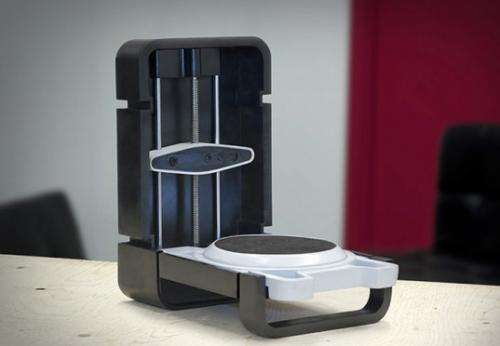(Phys.org) —Toronto-based Matterform showcased a 3D scanner at this year's CES with two attention-drawing features: It is easy to use for designers, hobbyists and consumers and it is priced below $600. The company promotes the scanner as requiring no assembly, ready to use out of the box. The goal is to get the user's target object from scanning platter to 3D printer as easily as possible. "Unfold it, plug it in, place an object on the scan bed and press go! It's that simple. Really," says the company site. After a successful crowdfunding campaign last year, the scanner team, Adam Brandejs and Drew Cox along with Trevor Townsend, are preparing to launch the $579 3D scanner next month. The team showed their scanner at CES earlier this month.
The Matterform device is small (one observer said it was something like a small hotplate with a lid; another said it looked like a little record player) and the user can fold up the base when not in use; the scanner has an integrated case that protects the components, turntable and camera. Their scanning system involves a moving HD camera with dual lasers inside the lid. The user puts the object on display on the bottom, on a rotating platform. The user clicks a button to scan and it is on its way.
Scans take anywhere from five minutes to longer, depending on several details. According to the company, "Our goal for our software is focused on quality, more than speed. That said, the speed of the scanner is dependent on a number of factors, including the speed of your computer, the size of the object and the quality of the scan. Scan times average around five minutes for one pass. For higher-quality scans or taller objects, additional passes will be required which will add to the total scanning time. The software will allow you to customize your scan to give you the optimum scan result for your use."
Further commenting on speed at the CES show, the team blogged, that the scanner does its work "in five minutes to 45 minutes depending on object volume, the head raises and knows when to stop all on its own and it clears out noisy data at the end. You never have to click more stuff. You click scan, wander off, come back and click save. That's it. If you want to watch the scan in real time, you can."
According to technical data, watertight 3D models can be created within 0.25 mm of the size and detail of the original object. Items can be scanned up to 190 mm x 190 mm x 250 mm in size while capturing approximately 2000 points a second. Matterhorn's software saves files as .STL, .OBJ and point cloud .PLY files. The box contains the scanner power cable, USB cable, calibration card and documentation. Software is downloadable with the user's special code. Matterform's list of supported platforms are, minimum: Windows 7 and Mac OS 10.6. Recommended are Windows 7+ and Mac OS 10.7+.
"We thought it would be popular with the hacker/maker crowd," said Brandejs, "but the applications are much broader than that. We've had interest from designers, artists, archeologists, dentists and even parents who want to scan their kids' artwork."
More information: www.matterform.net/scanner
© 2014 Phys.org
























